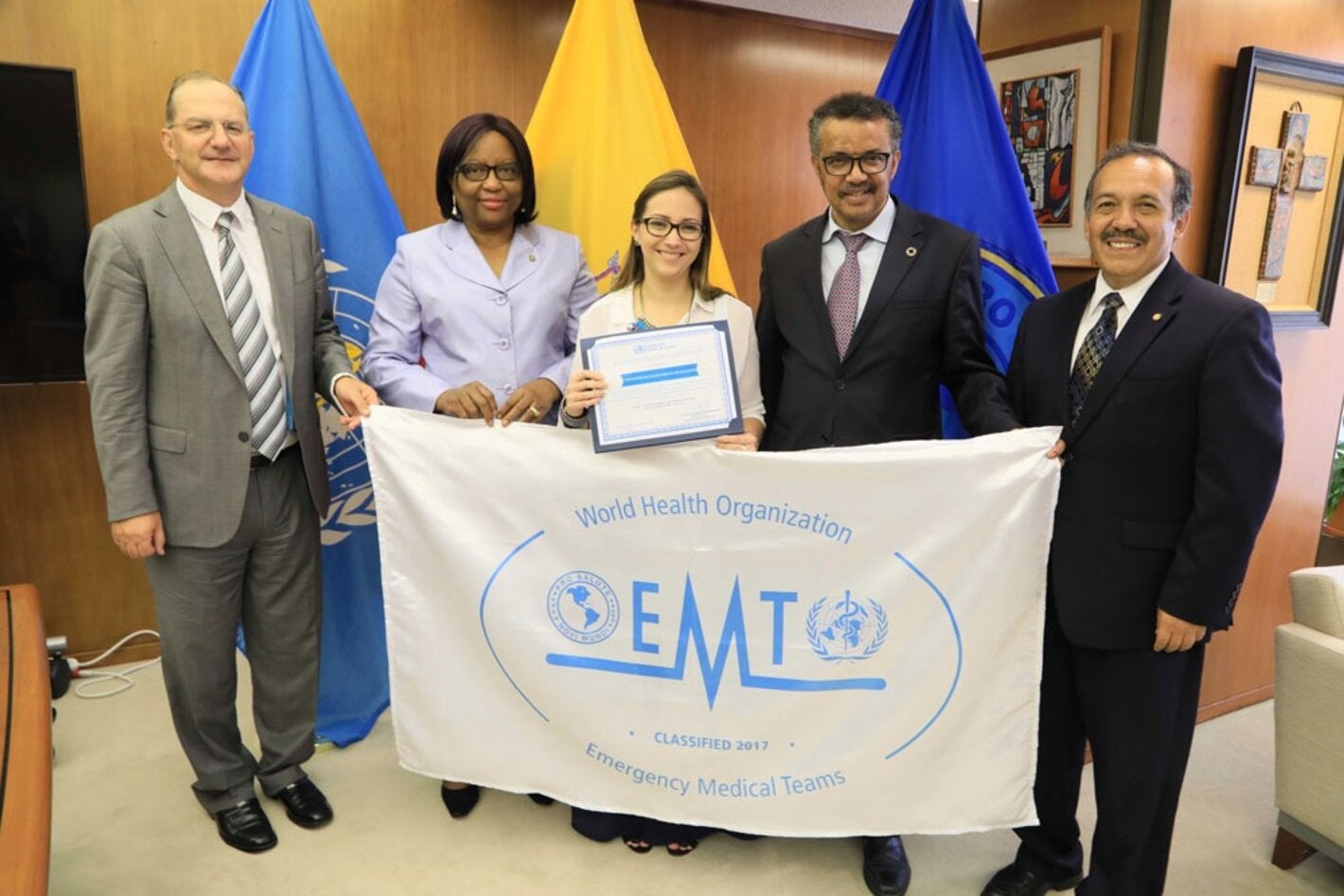The group will become part of the international list of emergency medical teams that can be deployed quickly when requested by countries affected by disasters or emergencies.
Washington, DC, September 26, 2017 (PAHO/WHO) - The emergency medical team of the Ministry of Public Health of Ecuador is the second in the Americas region to receive verification from the World Health Organization (WHO), as part of its Emergency Medical Team (EMT) initiative.
At a ceremony held today at the headquarters of the Pan American Health Organization (PAHO) in Washington, DC, WHO Director-General Tedros Adhanom Ghebreyesus presented the WHO EMT recognition to the Minister of Public Health of Ecuador, Verónica Espinosa, together with the Director of PAHO, Carissa F. Etienne. Both congratulated Ecuador on this accomplishment. "This is a very important achievement for Ecuador and we appreciate your support in reaching it," Minister Espinosa declared.
The purpose of this classification is to create an international listing to ensure a predictable and coordinated response from EMTs that have proven to comply with internationally agreed EMT standards and technicians.
"This is a way for Ecuador to return even a little, after everything we received following the earthquake" that hit the country in 2016, said Minister Espinosa.
EMT members from Ecuador undertook initial training, with the support of PAHO, just days before the earthquake on April 16 of last year. That training made it possible for Ecuador to respond to the disaster following the EMT standards. During the crisis, the Ecuadorian EMT group was able to integrate tools of coordination of the medical equipment and team response. In the months following the event, the Ministry continued to comply with WHO standards in terms of personnel, logistical issues, processes, and guides to achieve international recognition as an WHO emergency medical team.
Ecuador's medical team is the first in the Americas region to obtain this recognition for type 2, which means, among other things, that they can deploy a field hospital as well as provide care.
"We are very proud of this recognition achieved by Ecuador," said Ciro Ugarte, director of PAHO's Emergency Health Department, who added that few countries in the world have received this classification.
Type 2 EMTs administer 24-hour emergency care and can provide emergency ambulatory care, emergency general and obstetric surgeries, and treat fractures and wounds. Type 2 EMTs can deploy a field hospital with at least 20 beds, with laboratory services, radiology, surgery, transfusions and even a rehabilitation unit. They are totally self-sufficient during the time of their mission.
Between September 13 and 15, 2017, an international PAHO/WHO mission with experts from Costa Rica, Peru, and the United States verified compliance with the minimum standards for EMTs. These experts reviewed the documentation of processes, standards and guidelines for patient care, administrative and logistical processes, and the protocols for activation, displacement, and deactivation of EMTs. In Guayaquil, they evaluated the Mobile 1 hospital and its surgical unit. The Mobile 1 hospital is just one of the mobile hospitals and surgical units that have been adapted by the Ministry of Public Health of Ecuador to meet EMT classification. The unit can be deployed in less than 48 hours and transported by road using seven trucks.
EMTs are made up of health professionals (medical and nursing staff, physiotherapists, paramedics, etc.) who provide direct clinical care to populations affected by emergencies and disasters, and support for local health systems. These medical teams work under the overall guidelines of the Classification and Minimum Standards for Emergency Medical Teams in sudden disasters.
To date, EMT teams from Australia, China, Germany, Israel, Japan, New Zealand, Russia, and United Kingdom, have been recognized as WHO EMTs. Costa Rica was the first country in the region to join the list. Several other countries in the Americas are working hard to classify their own EMTs. One-third of the countries registered for the verification process come from the Americas.




